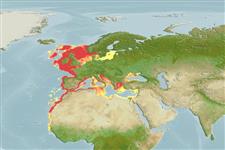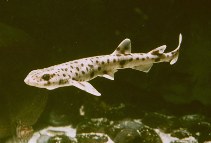Scyliorhinus canicula (Linnaeus, 1758)
Lesser spotted dogfish
把你的觀察加入 Fish Watcher
| Native range | All suitable habitat | Point map | Year 2050 |

|
| This map was computer-generated and has not yet been reviewed. |
| Scyliorhinus canicula AquaMaps Data sources: GBIF OBIS |
上傳你的 相片 和 影像
Pictures | Google 影像Scyliorhinus canicula
Picture by Aquarium Kiel
Pictures | Google 影像Scyliorhinus canicula
Picture by Aquarium Kiel
Italy country information
Common names:
Attaredda, Cacciottiello, Cacciuni
Occurrence: native
Salinity: marine
Abundance: | Ref:
Importance: | Ref:
Aquaculture: | Ref:
Regulations: | Ref:
Uses: no uses
Comments: Also Ref. 244, 120402.
National Checklist:
Country Information: https://www.cia.gov/library/publications/resources/the-world-factbook/geos/it.html
National Fisheries Authority:
Occurrences: Occurrences Point map
Main Ref: Costa, F., 1991
National Database: ICTIMED
Occurrence: native
Salinity: marine
Abundance: | Ref:
Importance: | Ref:
Aquaculture: | Ref:
Regulations: | Ref:
Uses: no uses
Comments: Also Ref. 244, 120402.
National Checklist:
Country Information: https://www.cia.gov/library/publications/resources/the-world-factbook/geos/it.html
National Fisheries Authority:
Occurrences: Occurrences Point map
Main Ref: Costa, F., 1991
National Database: ICTIMED
Common names from other countries
分類 / Names 俗名 | 同種異名 | Catalog of Fishes(屬, 種) | ITIS | CoL | WoRMS | Cloffa
Elasmobranchii 板鰓亞綱 (鯊魚與魟魚) (sharks and rays) > Carcharhiniformes (Ground sharks) 真鯊目 (Ground sharks) > Scyliorhinidae (Cat sharks) 貓鮫科 (Cat sharks) > Scyliorhininae
Etymology: Scyliorhinus: skylion, Greek for dogfish or small shark; rhinus, from rhine (Gr.), rasp, alluding to a shark’s jagged, rasp-like skin (See ETYFish); canicula: Diminutive of canis (L.), dog; sharks were known as “sea dogs” and “dog-fishe” among mariners until the late 16th century, because of their ferocious pack-like feeding behavior (See ETYFish).
More on author: Linnaeus.
Etymology: Scyliorhinus: skylion, Greek for dogfish or small shark; rhinus, from rhine (Gr.), rasp, alluding to a shark’s jagged, rasp-like skin (See ETYFish); canicula: Diminutive of canis (L.), dog; sharks were known as “sea dogs” and “dog-fishe” among mariners until the late 16th century, because of their ferocious pack-like feeding behavior (See ETYFish).
More on author: Linnaeus.
Environment: milieu / climate zone / depth range / distribution range 生態學
海洋 居於水底的; 深度上下限 10 - 780 m (Ref. 56504), usually 80 - 100 m (Ref. 81056). 亞熱帶的; 63°N - 3°N, 32°W - 37°E
分布 國家 | FAO區域 | 生態系 | 發現紀錄 | Point map | 簡介 | Faunafri
North Sea (sw coast of Sweden to Copenhagen, Denmark), Northeastern Atlantic Ocean (Ireland, United Kingdom, France, Portugal); Mediterranean Sea (Spain, France, Italy, Tunisia, Algeria, Morocco); nw Africa, close to the Strait of Gibraltar and to the north of Mauritania (20º30’N); including Norwegian Sea.
東北大西洋: 挪威與不列顛群島南至塞內加爾, 包括地中海。 可能地象牙海岸。 一些族群的差異在 Catulus duhameli(一個名稱對於以大小為依據的地中海 canicula) 與這種之間存在那可能最後被表示成亞種。 在克里米亞半島的水域的這種的唯一被報告的觀察在 1937 年, 是可能錯誤.(參考文獻 897)
東北大西洋: 挪威與不列顛群島南至塞內加爾, 包括地中海。 可能地象牙海岸。 一些族群的差異在 Catulus duhameli(一個名稱對於以大小為依據的地中海 canicula) 與這種之間存在那可能最後被表示成亞種。 在克里米亞半島的水域的這種的唯一被報告的觀察在 1937 年, 是可能錯誤.(參考文獻 897)
Length at first maturity / 大小 / 重量 / 年齡
Maturity: Lm 50.0, range 35 - 64 cm
Max length : 100.0 cm TL 雄魚/尚未辨別雌雄; (Ref. 244); common length : 60.0 cm TL 雄魚/尚未辨別雌雄; (Ref. 4645); 最大體重: 3.7 kg (Ref. 128278); 最大年齡: 12 年 (Ref. 81067)
Max length : 100.0 cm TL 雄魚/尚未辨別雌雄; (Ref. 244); common length : 60.0 cm TL 雄魚/尚未辨別雌雄; (Ref. 4645); 最大體重: 3.7 kg (Ref. 128278); 最大年齡: 12 年 (Ref. 81067)
簡短描述 檢索表 | 型態特徵 | 形態測量圖
This species is distinguished from all its congeners by the following characters: shallow nasoral grooves and laterally situated posterior nasal flaps (vs. no grooves and posterior flaps on the posterior border of the excurrent apertures in congeners, except in S. duhamelii); distance between the anterior nasal flaps 6-7.5 times smaller than the anterior nasal flap width (vs. 3.5-5 times smaller in S. duhamelii; two times in the other species); lower labial furrow 2.1-2.2 times smaller than mouth width (vs. more than 3 times in other species, except S. duhamelii). Colouration: color pattern with dark spots well-defined, predominantly smaller than spiracles (vs. no dark spots in S. capensis, S. comoroensis, S. hesperius, S. meadi, S. torazame, S. torrei; reticulated pattern in S. rotifer; dark spots predominantly larger than spiracles in S. cervigoni, S. garmani, S. haeckelii, S. stellaris; diffuse spots in S. duhamelii); clasper with rough terminal dermal cover (also found only in S. capensis) (Ref. 120402).
一個細長又有深色斑點的貓鯊具有大量擴大前鼻瓣, 達到嘴與覆蓋淺鼻溝, 唇溝只在下頜上, 第二背鰭鰭遠小於第一個 (參考文獻 244)
一個細長又有深色斑點的貓鯊具有大量擴大前鼻瓣, 達到嘴與覆蓋淺鼻溝, 唇溝只在下頜上, 第二背鰭鰭遠小於第一個 (參考文獻 244)
Most common catshark in coastal waters of Europe (Ref. 32804). Inhabits continental shelves and uppermost slopes. Found on sandy, coralline, algal, gravel or muddy bottoms. Occurs mainly between 10-100 m depth in the northeast Atlantic and up to 400 m depth in the Mediterranean Sea (Ref. 88187) and from 288-780 m in the eastern Ionian Sea (Ref. 56504). They sometimes occur in midwater. Nocturnal species, males resting on substrate and females hiding in shallow (0.5-1.5 m depth) caves and crevices during the day (Ref. 88835). Feed on a variety of benthic invertebrates, including mollusks, crustaceans, small cephalopods, polychaete worms, and small bony fishes (Ref. 244, 11889). Males have been found to forage in shallow prey-rich areas with soft sediment or areas covered with filamentous algae (Ref. 88836). Oviparous, with a single egg laid per oviduct at a time. Detect weak electric fields generated by other organisms (e.g. potential prey) (Ref. 10311). Utilized fresh and dried-salted for human consumption, also for oil and fishmeal.
棲息於大陸棚與最上面的斜坡。 棲息於了沙的﹐珊瑚的﹐和海藻的, 礫石或者泥底部深度幾公尺通常向下至 110 公尺。 有時出現於中層水域中。 吃軟體動物與甲殼動物,小的頭足類動物,多毛類的蠕蟲與小的硬骨魚類。 卵生的, 每個輸卵管只有一個卵一次。 生鮮使用與乾燥鹽醃供人類消費, 也用做魚油與魚粉。
棲息於大陸棚與最上面的斜坡。 棲息於了沙的﹐珊瑚的﹐和海藻的, 礫石或者泥底部深度幾公尺通常向下至 110 公尺。 有時出現於中層水域中。 吃軟體動物與甲殼動物,小的頭足類動物,多毛類的蠕蟲與小的硬骨魚類。 卵生的, 每個輸卵管只有一個卵一次。 生鮮使用與乾燥鹽醃供人類消費, 也用做魚油與魚粉。
Life cycle and mating behavior 成熟度 | 繁殖 | 產卵場 | 卵 | 孕卵數 | 仔魚
Oviparous, laying paired eggs (one per oviduct) in shallow subtidal areas, although some egg cases have been found in the deeper part of intertidal zones (Ref. 244). Embryos feed solely on yolk (Ref. 50449). The egg cases are anchored to macroalgae, sea grass or sessile erect invertebrates such as poriferans, bryozoans and hydroids (Ref. 32804, 58137). The capsules have tendrils at each corner used for anchorage purposes. Egg capsule size varies according to locality and female size (Ref. 244) and ranges between 4.9-7.0 cm length and 1.5-3.0 cm width (Ref. 88837). Egg cases may be deposited throughout the year, peaking in June and July (Ref. 32804). Recent studies estimate fecundity of females from the northeast Atlantic to be at around 29-62 pups (Ref. 32804). Fully formed pups hatch after 5-11 months, depending on water temperature (Ref. 244, 32804). Newly hatched pups are about 8-10 cm in length (Ref. 78469).
東北大西洋: 挪威與不列顛群島南至塞內加爾, 包括地中海。 可能地象牙海岸。 一些族群的差異在 Catulus duhameli(一個名稱對於以大小為依據的地中海 canicula) 與這種之間存在那可能最後被表示成亞種。 在克里米亞半島的水域的這種的唯一被報告的觀察在 1937 年, 是可能錯誤.(參考文獻 897)
主要參考資料
Upload your references | 參考文獻 | 合作者 : Compagno, Leonard J.V. | 合作者
Soares, K.D.A. and M.R. De Carvalho, 2019. The catshark genus Scyliorhinus (Chondrichthyes: Carcharhiniformes: Scyliorhinidae): taxonomy, morphology and distribution. Zootaxa 4601(1):1-147. (Ref. 120402)
對人類具威脅
無害處的
人類使用
漁業: 低經濟; 游釣魚種: 是的
FAO(漁業: 產生; publication : search) | FishSource | 周邊海洋
更多資訊
Population dynamics
成長參數
Max. ages / sizes
Length-weight rel.
Length-length rel.
長度-頻率
Mass conversion
入添量
豐度
成長參數
Max. ages / sizes
Length-weight rel.
Length-length rel.
長度-頻率
Mass conversion
入添量
豐度
工具
Bio-Quiz | E-book | 野外調查 | 檢索表 | 長度- 頻率 Wizard | 生活- 歷史的工具 | 分布圖 | Classification Tree
| Catch-MSY |
特別的報告
下載 XML
網路資源
Aquatic Commons | BHL | Cloffa | BOLDSystems | Websites from users | 檢查 FishWatcher | CISTI | Catalog of Fishes(屬, 種) | DiscoverLife | DORIS | ECOTOX | Faunafri | Fishtrace | GenBank(基因組, 核甘) | GloBI | GOBASE | | Google Books | Google Scholar | Google | IGFA World Record | MitoFish | 國家資料庫 | Otolith Atlas of Taiwan Fishes | 公眾的水族館 | PubMed | Reef Life Survey | Scirus | SeaLifeBase | 樹狀分類階層 | Wikipedia(去, 搜尋) | World Records Freshwater Fishing | 動物學的記錄
Estimates based on models
Preferred temperature (Ref. 115969): 7.2 - 16.2, mean 10.1 (based on 28 cells).
Phylogenetic diversity index (Ref. 82804): PD50 = 0.5000 [Uniqueness, from 0.5 = low to 2.0 = high].
Bayesian length-weight: a=0.00148 (0.00126 - 0.00174), b=3.20 (3.15 - 3.25), in cm Total Length, based on LWR estimates for this species (Ref. 93245).
營養階層 (Ref. 69278): 3.8 ±0.3 se; based on diet studies.
回復力 (Ref. 120179): 低的, 最小族群倍增時間4.5 - 14 年 (K=0.20; tm=9; Fec=96).
Prior r = 0.35, 95% CL = 0.23 - 0.53, Based on 1 full stock assessment.
Fishing Vulnerability (Ref. 59153): High vulnerability (59 of 100).
Climate Vulnerability (Ref. 125649): Moderate to high vulnerability (53 of 100).




